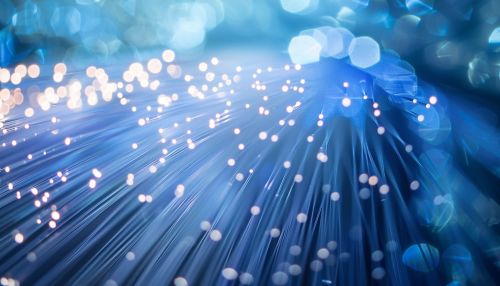Fiber optics
Introduction


Fiber optics, also known as optical fibers, are flexible, transparent fibers made of high-quality glass, plastic, or silica that transmit light between two ends of the fiber. These fibers are widely used in telecommunications, medical imaging, and various other applications due to their ability to transmit data over long distances with minimal loss. The technology behind fiber optics has revolutionized the way information is transmitted, offering high bandwidth and low attenuation compared to traditional metal wires.
History
The concept of fiber optics dates back to the mid-19th century when physicists such as John Tyndall demonstrated that light could be guided through a stream of water. However, it wasn't until the 20th century that the practical applications of fiber optics began to be realized. In the 1950s and 1960s, researchers developed the first practical optical fibers with low attenuation, paving the way for modern fiber optic communication systems.
Principles of Operation
Fiber optics operate on the principle of total internal reflection, where light is confined within the core of the fiber by the cladding, which has a lower refractive index. This allows the light to travel long distances with minimal loss. The core and cladding are typically made of silica, but other materials such as plastic can also be used.
Types of Optical Fibers
There are two main types of optical fibers: single-mode fibers and multi-mode fibers.
- **Single-mode fibers**: These fibers have a small core diameter, typically around 8-10 micrometers, and are designed for long-distance communication. They allow only one mode of light to propagate, reducing dispersion and increasing bandwidth.
- **Multi-mode fibers**: These fibers have a larger core diameter, typically around 50-62.5 micrometers, and are used for shorter distances. They allow multiple modes of light to propagate, which can cause modal dispersion and limit bandwidth.
Applications
Fiber optics have a wide range of applications across various industries:
Telecommunications
Fiber optics are extensively used in telecommunications due to their high bandwidth and low attenuation. They are the backbone of modern internet infrastructure, enabling high-speed data transmission over long distances. Fiber optic cables are used in submarine communication cables to connect continents and in fiber to the home (FTTH) installations to provide high-speed internet access to consumers.
Medical
In the medical field, fiber optics are used in endoscopy to provide minimally invasive imaging of the body's internal structures. Optical fibers are also used in laser surgery to deliver precise laser beams for cutting and cauterizing tissue.
Industrial
Fiber optics are used in various industrial applications, including fiber optic sensors for monitoring temperature, pressure, and strain in harsh environments. They are also used in robotics for precise control and communication.
Military and Aerospace
In the military and aerospace sectors, fiber optics are used for secure and reliable communication systems. They are also used in guidance systems for missiles and aircraft due to their immunity to electromagnetic interference.
Advantages of Fiber Optics
Fiber optics offer several advantages over traditional metal wires:
- **High Bandwidth**: Fiber optics can transmit large amounts of data at high speeds, making them ideal for high-bandwidth applications such as internet and video streaming.
- **Low Attenuation**: Optical fibers have lower signal loss compared to metal wires, allowing data to be transmitted over longer distances without the need for repeaters.
- **Immunity to Electromagnetic Interference**: Fiber optics are immune to electromagnetic interference, making them suitable for use in environments with high levels of electrical noise.
- **Security**: Optical fibers are difficult to tap into without detection, providing a higher level of security for data transmission.
Challenges and Limitations
Despite their advantages, fiber optics also have some challenges and limitations:
- **Cost**: The initial cost of installing fiber optic infrastructure can be high, although the long-term benefits often outweigh the initial investment.
- **Fragility**: Optical fibers are more fragile than metal wires and can be damaged if not handled properly.
- **Splicing and Connectorization**: Joining optical fibers requires precise splicing and connectorization techniques, which can be time-consuming and require specialized equipment.
Future Developments
The field of fiber optics continues to evolve, with ongoing research focused on increasing bandwidth, reducing costs, and improving reliability. Advances in photonic crystals and optical amplifiers are expected to further enhance the performance of fiber optic systems. Additionally, the development of quantum communication technologies holds the potential to revolutionize secure data transmission.
See Also
- Telecommunications
- Internet
- Endoscopy
- Laser Surgery
- Fiber Optic Sensors
- Robotics
- Guidance Systems
- Photonic Crystals
- Optical Amplifiers
- Quantum Communication
